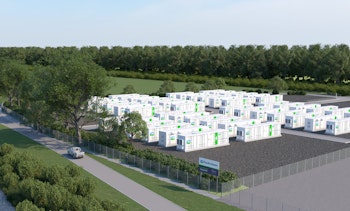These are exciting times for battery energy storage in post-Brexit Britain, according to the prestigious Faraday Institution.
“The UK is well placed to have a leading position in next generation batteries such as solid-state, lithium-sulphur and sodium-ion technologies,” chief executive officer Pam Thomas recently stated.
“The UK is already home to global experts in battery research, and to well-established companies.”
And market demand for batteries is growing. The country will need 10 gigafactories (large, high-volume battery manufacturing facilities) by 2040, each producing 20 GWh per year of batteries, according to the Faraday Institution in a recently updated report.
Stephen Gifford, chief economist at the Faraday Institution, added: “There is a growing sense of optimism that a highly productive and sustainable battery manufacturing industry can be built in the UK.”
“There is a growing sense of optimism that a highly productive and sustainable battery manufacturing industry can be built in the UK.”
Recent announcements of investment in energy storage appear to give substance to this positivity. As the first of three recent examples, battery-storage company Field recently raised £77 million of new funding for renewable energy infrastructure across the UK.
The company says it plans to get 1.3 GWh of battery storage operational across the country by 2024. Meanwhile, Britishvolt’s £3.8 billion lithium-ion battery gigafactory has been approved for construction.
The site, which will be built in four phases of around 10 GWh, has targeted 2024 as the start of phase-one production. The completed factory is predicted to produce 300,000 electric vehicle batteries per year.
The third recent story concerns the Mumbai-headquartered Hinduja Group, plus Caterpillar Venture Capital, Mercuria, OurCrowd and Volvo Energy.
They constitute five new investors in UK-based Connected Energy, which develops commercial-scale stationary energy storage systems from used electric vehicle batteries. Together, they have invested £15 million in Connected Energy’s second-life business.
According to Connected Energy chief executive Matthew Lumsden, when batteries are around 25% degraded, they are often considered unsuitable for vehicles. However, they still have sufficient capacity for up to 10 years more use in battery energy storage systems.
Over its lifetime in operation, a second-life battery can save an additional 450 tonnes per MWh of CO2 equivalent compared to using first-life lithium-ion batteries.
These stories in the press are good news, but do they reflect a genuine underlying increase in battery energy storage investment and development? Yes, according to RenewableUK.
Figures released by the trade body in April of this year show the UK’s energy storage pipeline has almost doubled in just one year. The total capacity of energy storage projects in operation, under construction, consented and in planning now stands at more than 32 GW.

Less than 1.6 GW of that capacity is operational and under 1.5 GW is under construction. But this still represents 45% year-on-year growth. And it means that the total installed capacity of utility-scale storage is now approaching 1.7 GW across 127 sites.
For several years, the UK has been gaining ground internationally as a place to do low-carbon business. The country gained fourth place on EY’s Renewable Energy Country Attractiveness Index in 2021, putting it ahead of green energy leaders France and Germany.
What is the secret behind the UK’s energy storage boom? Recent government policy commitments have set the stage for a green investment renaissance.
Chief among these is the 2022 British energy security strategy, which builds on the government’s ‘Net zero strategy’ and ‘Ten-point plan for a green industrial revolution’. The aim behind it is to unlock £100 billion in private investment.
This has helped create a positive environment for energy storage. The deeper goal is to foster a clean energy investment environment where energy storage becomes an essential part of the entire country’s infrastructure. But not all recent policy changes have been positive.
The government has recently closed a £300 million plug-in car grant scheme to new orders, according to the UK Department for Transport. It is a controversial reversal, not least as the policy has been yielding positive outcomes.
Battery-powered and hybrid electric vehicles now make up more than half of all new cars sold. Fully electric car sales have risen 70% in the past year and represent one in six new cars joining UK roads.

However, the £300 million in funding saved will now be directed towards extending plug-in grants to encourage sales of electric taxis, vans, trucks, motorcycles and wheelchair-accessible vehicles. Time will tell if its redeployment will be as effective as the previous policy.
Ensuring the UK Government and other stakeholders keep up the pace of support for decarbonisation is essential to continue the growth in UK energy storage. The Faraday Institution has identified key areas that need continued or increased focus.
According to the organisation, it is essential to keep the investment funds flowing by communicating the attractiveness of the UK as a global and regional battery manufacturing location to global investors.
Identifying prospective sites for gigafactories and the construction of associated physical, transport and energy infrastructure by the local, regional and national government is also highlighted as an important factor.
Another requirement is developing requisite electric vehicle battery skills and training infrastructure.
Support for research is also essential, providing long-term commitment to mission-based innovation into next-generation batteries that are cheaper, lighter, longer-lasting, safer, easier to manufacture, and more fully recyclable.
Developing a strategy to localise and create an efficient, resilient and sustainable UK supply chain is key to improving the availability and affordability of essential materials for battery production.
Lastly, developing a strategy to create the conditions for a new lithium-ion battery recycling industry in the UK will be an important step in ensuring the ongoing viability of British battery businesses.
If these goals are accomplished, there is no reason why the current promise shown by the UK market cannot go from strength to strength, which is good news for battery project developers such as Pacific Green.
Just as the battery manufacturing supply chain is beginning to mature, we are engaged in an ambitious buildout of projects such as Richborough, demonstrating the value of the technology to investors and to the grid.
To find out more about working with us to benefit from the tremendous opportunities awaiting investors in the UK energy storage market, contact us now.
Publish date: 22 September, 2022